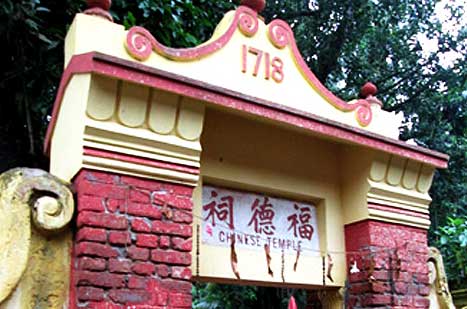Places of Interest

Achipur Near Bawali 
Achipur is the site where one of the earliest sugar mills in India was set up in 1770’s by a Chinese businessman Tong Achew. The then Governor General Warren Hastings offered land to Tong Achew to set up his sugar factory. Chinese workers were brought by Achew to work in his factory. The Chinese population of Kolkata owes its origins mostly to the workers and associates of Tong Achew. The tomb of Tong Achew and his Chinese Temple built in 1718 still stands at Achipur.
Bawali History 
The origin of the name “Bawali” is usually traced to a local tribe of the same name residing in this area around 500 years back. Being honey-collectors and wood cutters, the Bauli tribesmen were the earliest residents of this area. Another contradictory local folklore attributes the name to some Bawali Fakir who is said to have lived in these villages. However, no traces of his existence has ever been found in these areas.
Sometime during early 17th century, Basudeb Ray a prominent official of the Mughal Court of Emperor Akbar was bestowed the Zamindari of the area of Bawali. His decendant Harananda Mondal was one of the earliest to found the Zamindari at Bawali with the help of the Bawali tribesmen. The illustrious Zamindari grew with its effective land reforms and trade partnerships with the British. The Mondals of Bawali soon became a name to be reckoned with amongst the Zamindars of Bengal.
A temple-building frenzy soon ran amongst the Zamindars of Bawali and within 70 years a series of the finest temples of Bengal were built in and around Bawali. The Gopinath Jiu Temple built in 1794 with its nine-domes (Navratna) adorned with terracotta murals, the Radhakanta Jui Temple (1796), the Radhaballab Jiu temple (1813), the Shyamsundar Temple (1863) and many more Rashmanchas, Palaces, Jal Mahals, Dol Manchas and Nat Mandirs were built in this era. Though most of these temples are in ruins today, still Bawali hosts a 300-year old Rath Yatra of Manickchandra Mondal and the 200-year old Kalipuja, Charak and Goshto Yatra.
The nearby villages and towns of Bawali also has its fair share of some fascinating history like:
Budge Budge: Just 10 kms from Bawali, the nearby Budge Budge township’s facinating history dates back to 1756 when a local fort manned by the troops of Halders were defeated by Robert Clive’s forces. All ammunitions were brought to Fort William in Kolkata and the Budge Budge Fort was closed in 1793. The remains of the fort cannot be traced anymore. Budge Budge has witnessed some of the most fascinating events of Indian history like the homecoming of Swami Vivekananda from his Chicago visit in 1897. He landed at Budge Budge Ferry Ghat and boarded the train to Kolkata from the old station. Another event, to make a profound effect on the nationalist movement of India was the Komagata Maru incident also known as Budge Budge Riot in 1914. A Sikh nationalist Gurdith Singh with 19 other comrades were shot by the British Forces in his Japanese ship Komagata Maru while it docked in Budge Budge for protesting against the Exclusion Laws in Canada. A memorial still stands on the banks of the Hooghly River remembering this massacre.
Achipur: Achipur is a small riverside hamlet like many others in the vicinity but its claim to fame is due to the Chinese Temple built in 1718. Named after Tong Achew, a Chinese businessman who started a sugar factory after Governor General Warren Hastings handed some land to him. With Chinese immigrant workers, Tong Achew became a strong force in his business. The Chinese population of Kolkata owes its origins mostly to the workers and associates of Tong Achew. The tomb of Tong Achew and his Chinese Temple still stands at Achipur. Another intresting ruin is the Barood Ghar or the Gunpowder Godown located on the banks of River Ganges. During British rule, ships coming towards Kolkata from Bay of Bengal carrying gunpowder had to deposit their stock in these godowns located just beside River Ganges. Ships were only allowed to carry 100 lbs with them for emergency calls. While returning they would pick-up their stocks and sail back.




 +91 8100181600
+91 8100181600 bawalifarmhouse@gmail.com
bawalifarmhouse@gmail.com


